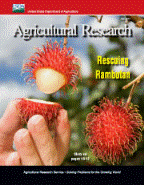United States Department of Agriculture: Agricultural Research Service, Lincoln, Nebraska

Agricultural Research Magazine
Date of this Version
1-2013
Document Type
Article
Citation
Agricultural Research January 2013
Abstract
Livestock producers may not be able to see the difference between stable flies and other flies at a distance, but they can definitely see the stable flies’ effect on their cattle as the animals stop grazing and bunch together to minimize the number of bites they’re getting.
Stable flies are among the most important arthropod pests of cattle in the United States. Their painful bites can reduce milk production in dairy cows, decrease weight gain in beef cattle, and reduce feed efficiency.
Generally, insecticide sprays are used to help keep stable flies off animals, especially their legs, where the flies mainly bite. But as cattle walk through wet grass or wade through water, the spray washes off—making the treatment ineffective. Management of this pest is further complicated by the fact that larval development sites exist for only a short time, are difficult to find, and can produce huge numbers of the aggravating flies.
Scientists at the Agricultural Research Service’s Agroecosystem Management Research Unit (AMRU) in Lincoln, Nebraska, are looking at better methods to locate stable fly habitats, finding easier and more efficient ways to control them, and assessing the damage they cause.
A Heavy Cost for Cattle Producers
What’s the cost of stable fly damage? It’s something livestock owners need to know.
“If you tell a producer that a site is the source of lots of flies and needs cleaning up, that producer wants to know if it is worth the time and expense,” says AMRU entomologist David Taylor. “We wanted to provide a costbenefit analysis.”
Taylor and his colleagues developed a model to assess the economic impact of stable flies using four classes of production: dairy, cow/calf, pastured and range stocker, and animals on feed. They found that each year, stable flies cost the U.S. cattle industry more than $2.4 billion, making them the most damaging arthropod pest of U.S. cattle.
As their name implies, stable flies have historically been associated with stables and barnyards. But over the last 30 years, they have become a significant pest in pastures too. Research indicates that the problem is partly due to the large bales of hay placed in fields as supplemental feed for cattle during the winter.
Included in
Agriculture Commons, Animal Sciences Commons, Food Science Commons, Plant Sciences Commons

